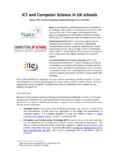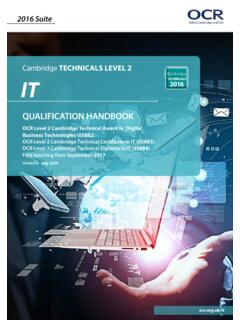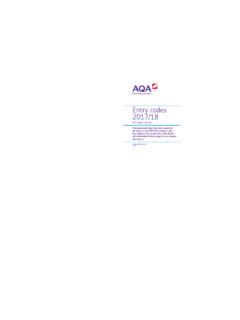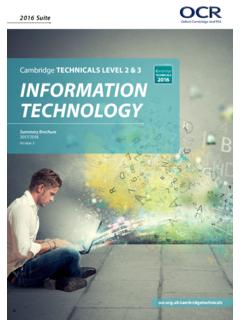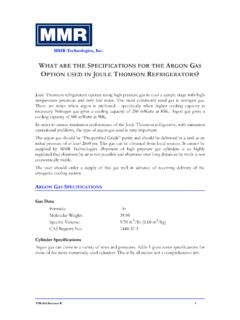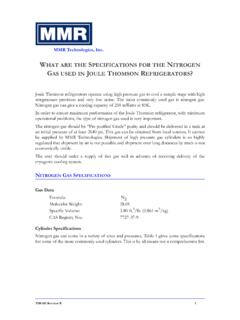Transcription of GCSE Design and Technology Guide Companion
1 GCSE Design and TechnologyYour Companion Guide to our new specificationFind out more teaching September 2017 First assessments summer 20192 GCSE Design and Technology key datesDownload our draft specification at 19 May 2016 Attend one of our free launch eventsAutumn 2016 Download our accredited specification from 2016 Start teachingSeptember 2017 First examsSummer 2019 GCSEs will be graded 9 1 All new GCSEs will be graded 9 1, rather than A* G. Grade 9 will be the highest and equivalent of an A** (which doesn t exist at the moment). Introducing our new GCSE Design and TechnologyWe ve created this Guide to help you understand how the new GCSE changes from Ofqual and the Department for Education will affect you and your changes will apply to all exam boards offering GCSE Design and Technology from September 2017.
2 All GCSEs will be linearStudents will sit all exams at the end of the two year more information about GCSE changes, visit Design AND Technology We re here if you need usWant to speak to someone in the GCSE Design and Technology team? T: 0161 957 3334E: our draft specifications: out more about the new GCSE grades: We re also hosting numerous showcase events and free prepare to teach events, to ensure you re fully prepared to teach the new specification in September specification foryou and your studentsCreating a new GCSE Design and Technology qualification that meets the needs of you and your students is extremely important to us.
3 That s why we ve worked with teachers and subject experts to Design a new specification that you ll enjoy teaching as much as your students will enjoy We re confident you ll find the new specification engaging, interesting and practical to We ll provide teaching resources to help you plan your lessons, teach and assess your students. 4 Specification at a glanceThe qualification is linear, meaning students sit all their exams at the end of the 1 What s assessed Core technical principles Specialist technical principles Designing and making principlesHow it s assessed Written exam: 2 hours 100 marks 50 % of GCSEQ uestionsSection A: Core technical principles (20 marks)Multiple choice and short answer questions assess broad technical knowledge and understanding.
4 Section B: Specialist technical principles (30 marks)Several short answer questions (2 5 marks) and one extended response to assess a more in depth knowledge of technical C: Designing and making principles (50 marks)Short and extended response questions, includes a 12 mark Design question. 4 Find out moreYou can see full details of the new specification at: Design AND Technology +Non-exam assessmentWhat s assessedPractical application of: Core technical principles Specialist technical principles Designing and making principlesHow it s assessed Non-exam assessment (NEA) approximately 30 35 hours 100 marks 50 % of GCSEWhat should students produce Substantial Design and make task.
5 Assessment criteria to include the following: investigating designing making analysing and the spirit of the iterative Design process, the above should be awarded throughout each stage of the Design (s) Contextual challenges to be released annually by AQA on 1 June, in the year before submission. Students will produce a working prototype and a portfolio of evidence (maximum 20 pages) to demonstrate the assessment criteria above. Work will be marked by teachers and moderated by Opportunity to explore a particular material area in greater depth.
6 Students can also take a product Design type approach and use multiple materials. We ve highlighted good areas to integrate relevant maths and science you ll enjoy teaching this new AQA specification Imaginative practical work is at its heart. Students explore, Design , create and evaluate prototypes to solve real world problems. Students gain a broad understanding of technical, designing and making principles. No restrictions on materials when making prototypes. Question paper split into three sections, which mirror the three content areas of the the new assessment will work 50% exam (maths and science knowledge contributes 15%).
7 50% non-exam assessment (NEA), one practical activity (students develop a brief in response to a contextual challenge set by AQA, released on 1 June in the year before submission).7 GCSE Design AND TECHNOLOGYC lear assessment and marking you can trustWe know the time and effort that you and your students put in to exams. We also understand how essential it is that the marks we give are fair, reliable and trustworthy. Getting the right resultsOur Centre for Education Research and Practice (CERP) provides statistics and research evidence to ensure we assess and mark your students work fairly and accurately.
8 We also recruit and train the highest calibre examiners and continually monitor their question papersStudents of all abilities will understand our clearly worded exam structured mark schemes and exemplar materialsOur mark schemes demonstrate how to help your top ability students get the best marks. Our exemplars use real student answers with comments from senior examiners to explain how our mark schemes are applied. Assessment supportOur exam resources will help you prepare for exams: these include practice questions, tests and revision exercises. If you d like to speak to us about the new exams, call us on 0161 957 exam help and advice available1.
9 Watch our videos on assessment explained or see how we create a specification at Analyse student results with our free Enhanced Results Analysis tool More exam-related help is available at to improve your teaching skills?We can support you throughout your teaching career with practical training, tried, tested and taught by and book our professional development events at mark schemes student exemplar materials training and professional development opportunities digital resources help you bring the new specification to lifeWe ve worked closely with fantastic teachers to create resources you ll find useful and resource will help you with a specific aspect of teaching either planning your lessons, teaching them, or preparing your students for exams.
10 Free resources include: events to introduce you to the new specification and advice on how you can teach it schemes of work and lesson plans specimen question papersJoin the conversation@AQACPD9 GCSE Design AND TECHNOLOGYL evel 1/2 Technical AwardsTo complement our new GCSE we are also developing a suite of Level 1/2 Technical Awards in this area, for first teaching in September new Technical Awards give 14 16 year olds a more hands-on, practical approach to learning. With a greater focus on specialist skills, students can concentrate on the area they re really interested in.











